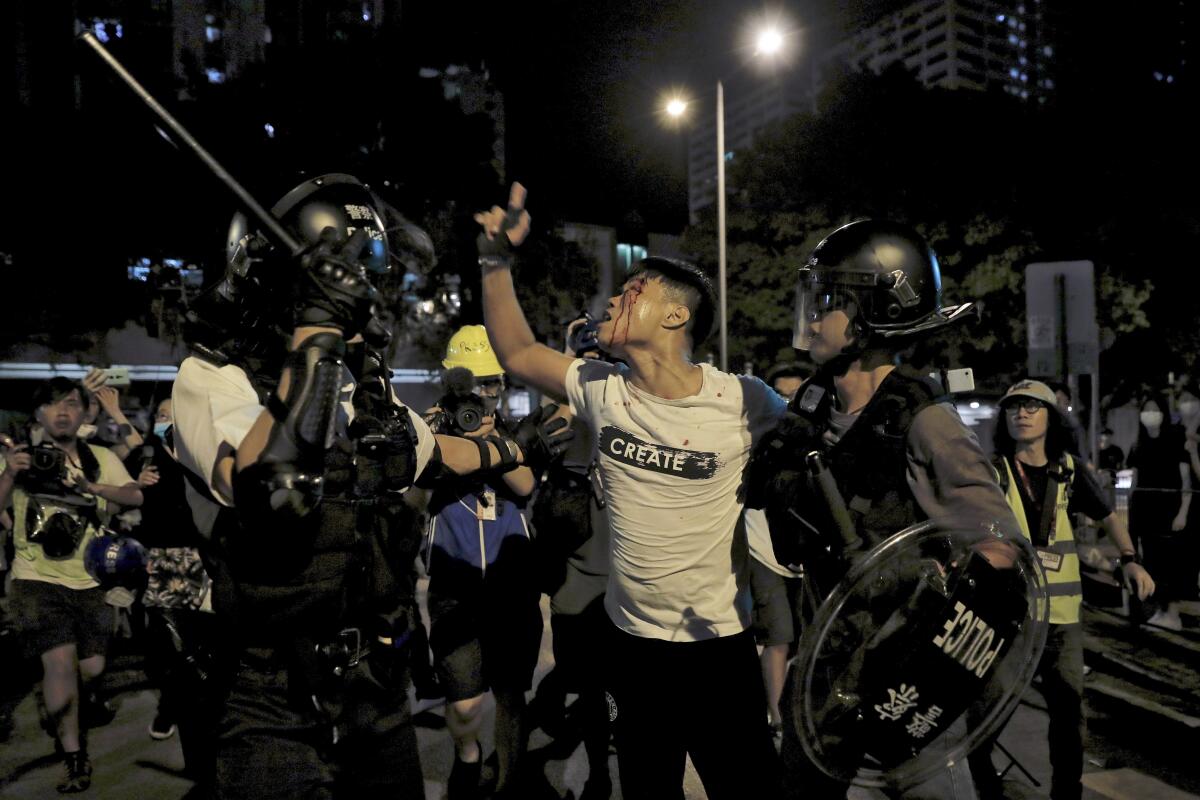Amid protests, defiance against Kremlin and Beijing rises

- Share via
MOSCOW and HONG KONG — Mass demonstrations are expected to continue in Moscow and Hong Kong this weekend, with protesters in both cities challenging their respective authoritative governments. In both cases, the police response has become increasingly more violent as the protesters remain defiant. Here’s what you need to know.
What are the protests in Russia about?
Demonstrations in Moscow started a month ago after several independent candidates’ applications were rejected for the Sept. 8 City Council elections. Normally, Muscovites don’t pay much attention to elections to fill the 45-seat city government. (Five years ago, the turnout was only 21%.) But frustrations across the country are building as more and more Russians feel their voices aren’t being heard in local issues. In Moscow, demonstrators said the authority’s blatant abuse of power to reject non-Kremlin aligned candidates from the regional government hit a nerve. At first, hundreds of protesters held daily demonstrations in front of Moscow Mayor Sergei Sobyanin’s office and the election commission. Then on July 20, more than 22,000 people attended a government-sanctioned rally in Moscow for fair elections. On that day, opposition leader and Kremlin critic Alexei Navalny called for another demonstration on July 27 if the independent candidates were not allowed on the ballot. By some estimates, 10,000 turned out on July 27. But that wasn’t a sanctioned rally, and protesters faced a harsh police crackdown that included violent beatings with truncheons and the arrest of nearly 1,400 for participating in an unsanctioned rally. The opposition has called for another protest on Aug. 3.
How has the Kremlin responded?
The Kremlin is clearly rattled by tens of thousands of anti-government protesters in the center of Moscow. Police have arrested Navalny and several of the rejected candidates for organizing an unsanctioned rally. The courts sentenced them from one week to a month in jail. Russian security officers searched the homes of several activists. One Russian media outlet reported that the Kremlin believed the protests were being backed by foreign influences intent on starting a “color revolution,” a reference to protests that have overturned governments in other post-Soviet republics.
State media outlets ignored the violent skirmishes between protesters and police on July 27, while independent media running live streams online of the protest were visited by the police, and their editors called in for questioning. The Investigative Committee, which considers large-scale crimes, opened criminal cases against five activists on charges of inciting riots. If convicted, they could get 15-year terms. Meanwhile, days after starting his 30-day jail term, Navalny was rushed to the hospital with a mysterious rash his doctor claimed could have been a poisoning.
Is this a repeat of the mass protests of 2011 and 2012 in Russia?
At this point, these protests pale in comparison with the size of the 2011 and 2012 protests, in which hundreds of thousands of demonstrators marched in central Moscow and other major Russian cities against election fraud. The Kremlin reacted swiftly to prevent future demonstrations, Russia adopted laws in 2013 to impose severe penalties on protesters who engage in unauthorized demonstrations.
But the July 20 protest saw the biggest turnout in Russia since Bolotnaya. If the Bolotnaya protesters were largely liberal, middle class Russians, today’s protests are dominated by a younger generation of Russians, many of whom ignore state-controlled media and are too young to remember and fear the police crackdowns of 10 years ago.
What does this mean for Putin? What comes next?
The Moscow protests are part of a trend of local demonstrations showing a growing defiant stance against Russian President Vladimir Putin’s managed democracy. Russia’s economy is sluggish, and Western sanctions have pinched investment and growth. Russians are particularly incensed about Putin’s pension reforms, which will increase the retirement age, a move many Russians see as the government trying to squeeze more money out of their shrinking wallets. Many demonstrators say the anger on the streets is about the Kremlin’s system of enriching the elites while ignoring the needs of ordinary Russians. Putin remains popular, but many feel the Kremlin’s forays onto the international stage, including the annexation of Crimea, diplomatic rows with the West and the Syrian war, have diverted attention away from growing domestic concerns. After the swift crackdown on July 27, there is growing worry about what the Kremlin response on Saturday could be. Demonstrators are calling for a march along Moscow’s scenic Boulevard Ring in the center of the city.
Critics say the Kremlin has backed itself into a political crisis.
“The major intrigue is related to the problem that the Kremlin doesn’t have a strategic plan on how to manage this,” said Tatyana Stanovaya, the founder of R.Politik, a political analysis firm, and a nonresident scholar at the Carnegie Moscow Center.
What are the protests in Hong Kong about?
Hong Kong protesters have been demonstrating for eight weeks against a proposed extradition bill that would have allowed suspected criminals to be deported to China. Protesters feared the bill would threaten rule of law and freedom of speech in Hong Kong, which enjoys semi-autonomy as a former British colony handed over to Chinese rule in 1997. Hong Kong’s chief executive Carrie Lam has suspended the bill but not withdrawn it. The protests started out as peaceful million-person marches but have become weekly violent clashes with police who shoot tear gas and rubber bullets at protesters who’ve vandalized government buildings and thrown bricks and umbrellas at the police. The protesters’ demands have now expanded to five items: withdrawal of the extradition bill, Lam’s resignation, an independent inquiry into alleged police violence, release of political prisoners, and electoral reform.
How has China responded?
China’s highest government office for Hong Kong affairs said Monday that Beijing fully backs the Hong Kong police and government and wants local authorities to restore “law and order.” Rumors are flying of potential Chinese military intervention in Hong Kong, but so far Chinese officials have only pointed to Article 14 of Hong Kong’s Basic Law, which says the People’s Liberation Army will not intervene in local affairs unless requested by Hong Kong’s government to “maintain order” or in disaster relief. Analysts say military intervention is unlikely. At the same time, Chinese media and officials are stoking nationalist anger at home and directly accusing the United States and CIA of orchestrating protests. Almost 200 people have been arrested in relation to the protests so far, including 44 who were charged this week with “rioting,” an offense punishable by up to 10 years in prison.
Is this a repeat of the mass protests in 2014?
It’s more like a sequel. In 2014, mass student-led protests occupied Hong Kong’s main streets for two and a half months, demanding electoral reform so that Hong Kong would have true universal suffrage. The protests were dubbed the “Umbrella Movement” when protesters started using yellow umbrellas to protect themselves from police firing tear gas. The movement ended without achieving any of its goals, and most of its leaders were imprisoned. The anti-extradition bill movement had much wider initial support from across Hong Kong’s society, including the legal and business sectors, which play a key role in the international financial center. But it’s also escalated faster. Both police and protesters are more aggressive than in 2014, with more hospitalizations and arrests. At least four people have committed suicide in relation to the protests. Last month, local gangs called triads beat up protesters and civilians at random in a mass transit station, shocking a city that’s used to being one of the safest in the world. Another difference from 2014 is that these protests are decentralized, with no core leadership. That means protesters are more flexible — “be water,” a Bruce Lee quote, is one of their mantras — but also unpredictable, as no one commands what happens next
What does this mean for Xi Jinping? What comes next?
The protests come at a tricky time for Xi, who’s mired in the U.S.-China trade war and determined to portray a strong image of himself and China this year, the 70th anniversary of the People’s Republic of China. Hong Kong protesters have directly challenged Xi and the central government’s authority by vandalizing the Beijing government’s Liaison Office in Hong Kong. They are chanting pro-independence slogans in the streets, coined by activist Edward Leung, who’s currently in prison alongside pro-democracy leaders of the 2014 protests. Analysts say Xi wants to avoid a repeat of the Tiananmen Square massacre in 1989. At the same time, giving in to protesters’ demands would signal unacceptable weakness. Xi appears to be waiting, hoping the protests will die out on their own, while also relegating responsibility to the Hong Kong government, so that local authorities and police can be blamed for any potential mistakes.
Ayres is a Times special correspondent. She reported from Moscow. Su is a Times staff writer and reported from Beijing.
More to Read
Sign up for Essential California
The most important California stories and recommendations in your inbox every morning.
You may occasionally receive promotional content from the Los Angeles Times.















